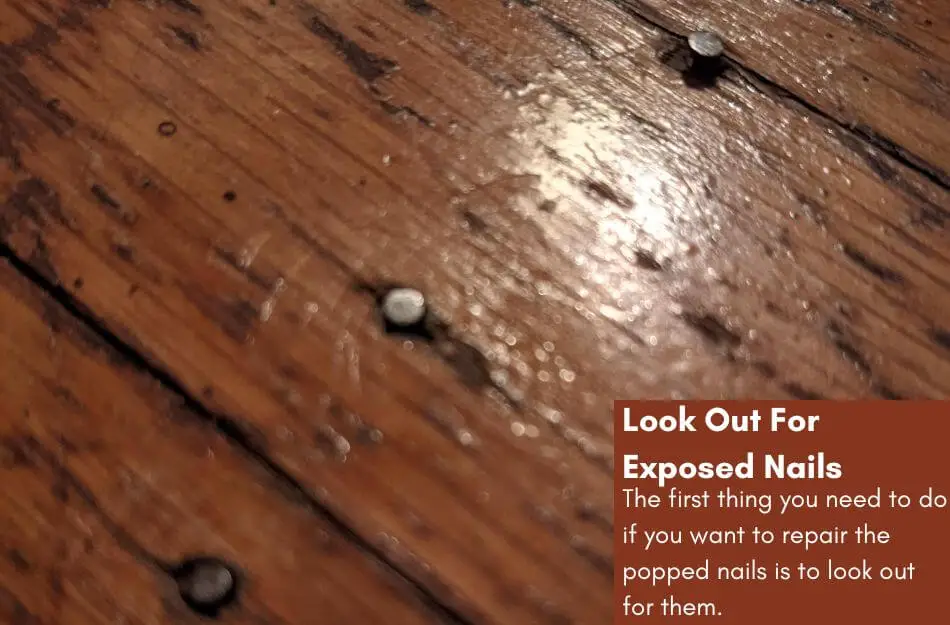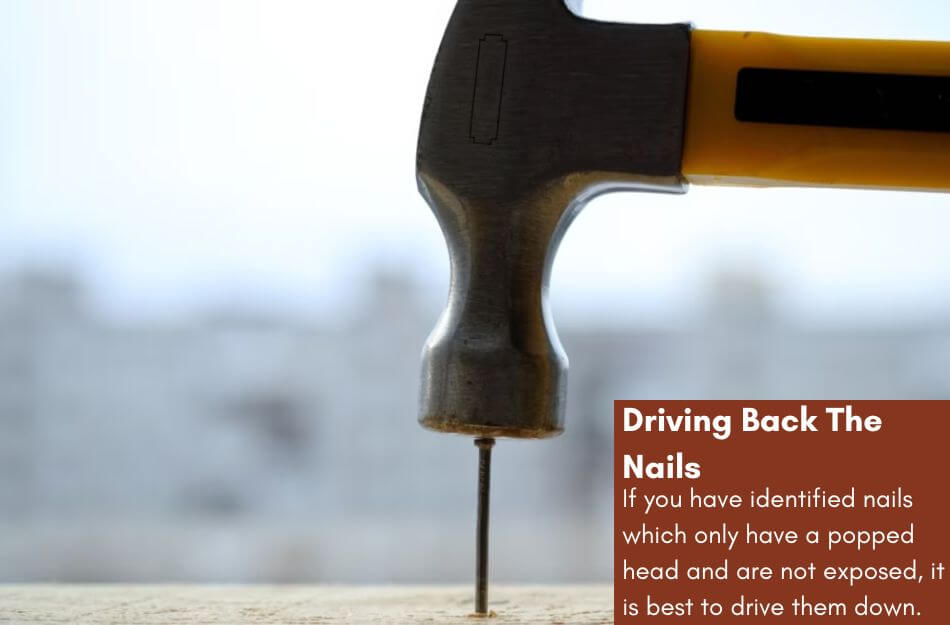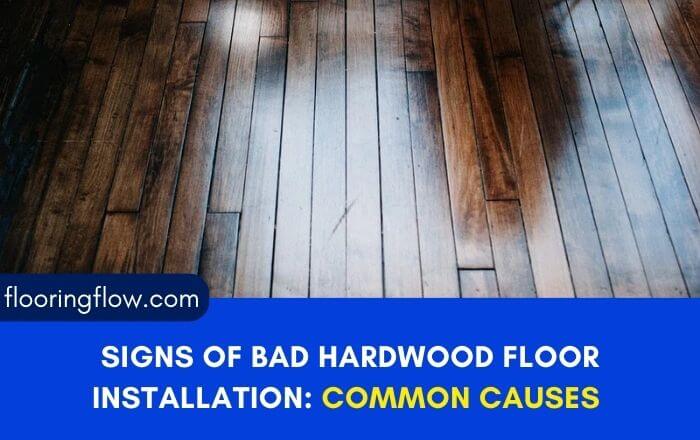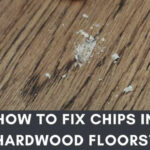Nails are an integral part of the installation of hardwood floors. However, due to various reasons, they might come off from the boards and may even pop out from the hardwood floors.
This can be a nuisance for many homeowners as they need to drive them back again and again before they come out once more.
However, contrary to many common beliefs, the nails in hardwood floors can be fixed so they don’t come out again and again.
The best way to fix nail pops in hardwood floors is to drive back the nails or replace them and then add a few screws to hold the entire structure in place. Not only will this keep the planks in place, but will also help to prevent the nails from popping out.

However, there is a final step which can be the key to this process which is mentioned at the end so make sure to check it out.
Table of Contents
Why Do Nails Keep Popping Up on a Wood Floor?
Several reasons can cause the nails to keep popping up from the wooden surface, such as acclimation of the wood, use of wrong nails, improper installation, and more.
Below are some common reasons why the nails keep popping out even after so much you’ve done to prevent it.
Wood Acclimation
Wood is a natural material that adapts to environmental conditions and changes accordingly.
One of the major changes seen in the wood is the contractions and expansions due to humidity, commonly known as acclimation.

While temperature has its due role in this process, humidity plays a major role.
As soon as the moisture content in the air goes up, the wood starts absorbing it from the air to the point where the moisture level of the air and the wood are the same.
Similarly, when the moisture level drops in the air, the same happens with the wood as it gives off moisture to achieve equilibrium with the environment.
Besides, this expansion and contraction in the wood fibers can cause the nails to become loose and slowly come out over time as they receive a shaking every time someone walks on the floors.
Besides, there is another reason for it which you must know.
Hardwood floors can soak up water, and due to the increased moisture content, they are firmer and propel the shockwaves of someone stepping on them to the entire board.
This can result in extensive shaking of the nails, which might cause them to loosen up or even come out of the wood.
In addition, the increased moisture content can also result in the corrosion of the nails if they are not rust-resistant and might lead to them losing their grip over time and becoming loose, hence popping out of the hardwood floors.
In most areas, the nails are not as visible, and only the heads pop up a bit; however, this is still dangerous for those walking bare feet or only with socks, and in worst-case scenarios, it may even result in tripping or other such hazards.
The Wrong Nails Were Used
Choosing the right type of nails for the wood is crucial; if ignored, you might face issues such as popping nails into hardwood floors.
As mentioned earlier, rust is one of the factors which can cause this problem. Therefore, you can use rust-resistance nails to ensure that the moisture content of the wood does not affect the health of the nails.

However, it does not end here, as other factors are also in play. Firstly, not all nails are made for the same purpose, and not all of them are designed so they can get deep into the wooden planks.
This might cause them to lose strength over time, resulting in popping, bending, or even breaking.
For instance, conventional nails are made to penetrate only an inch of the wooden surface, while the lag screws can go much deeper, making them difficult to pull out due to their strength inside the wooden structure.
Lastly, the shape of the nails is also a crucial factor in determining if they can stay inside the wood.
Smooth nails can come out more easily than spiral or ring-shaped ones as their designs allow more friction and resistance and hence, a better hold.
Nails were Driven In Wet Wood
Another common mistake many homeowners and even professionals make is driving nails into wet wood.
If you have washed the wooden planks or they are wet for any reason, you must let them dry before you can fix them using nails or screws.

The reason is that the wood has a high moisture content during wet conditions and has expanded.
Once the moisture is released from the surface and the wood starts to dry, it contracts, and the fibers come closer to each other.
This can build extreme pressures, which might cause the nails to come out due to excessive force from all sides.
Hence, it is best that you drive the nails into the wood only when it has dried completely.
Excessive Acclimation
While the wood needs to acclimate before it can be fixed into the subflooring structure, you must also ensure that the hardwood floors should not acclimate repeatedly as it can make the wood wearer and cause the nails to come out over time.
Excessive acclimation refers to the point where the wood has acclimated once naturally, but then you wash it or clean it with water repeatedly.
This causes the wood to become wet and dry several times, making the nails loose and forcing them to pop out of the wooden boards.
The expansion and contraction of the wood can cause serious damage to the surface of the wood and the nails.
Besides, hammering the nails back into the wood will not make any significant difference other than damaging the wood from the inside.
Therefore, it is necessary to ensure that the hardwood floors are kept dry mostly, and if the nails are popping from the hardwood floors, work on fixing them properly rather than hammering them back into the wood’s surface.
How To Fix Nail Pops In Hardwood Floors?
The best way to fix nail pops in hardwood floors is to look out for nails that have only the head popped up and drive them back in; as far as exposed nails are concerned, you must pull them out and drive new nails in place for a firm grip.
If you are having trouble understanding it, a detailed step-by-step guide is below.
Look Out For Exposed Nails
The first thing you need to do if you want to repair the popped nails is to look out for them. Identifying the exposed nails is very important, so you can’t repair them otherwise.

Here are a few effective ways of locating exposed nails on your hardwood floors:
- Run your hand on the boards where nails are placed to see if anyone feels elevated from the surface.
- Shine a light on the nailed area to see if the exposed nails reflect any or if you can see nail heads popped out.
- Look for planks which are lifting, as these might also indicate rising or popping nails.
Once you have successfully identified all the nails above the surface or have popped out completely, you can move towards fixing them.
Remove Exposed Nails
It is important to understand that nails which have been exposed should not be driven inside again and should be removed immediately.
Exposed nails have lost their grip on the wood driving them back can be dangerous and damaging to the wood inside.

Hence, it is only wise to pull it out of the surface. You can use either a claw hammer or needle-nosed pliers for this purpose.
However, it is highly possible that you might damage the floors while removing the nail.
Therefore, it is best to be as cautious as possible and cover the area around the nail so you don’t end up scratching or denting the floors.
Besides, if a nail is too stubborn to be removed, it is best to drive it back in, as removing it can cause splinters in the wood and other such problems.
Driving Back The Nails
If you have identified nails which only have a popped head and are not exposed, it is best to drive them down.
Besides, you can do the same for the exposed nails, which are stubborn and don’t allow to be pulled out.

Moreover, if the nail is just barely exposed and/or the floor is lifting, it is preferred that you do not attempt removal but drive the nail back down to fix it into its designated place.
However, remember that directly hitting the nail on the floor will damage the wood and even cause breaking.
Therefore, it is recommended that you place a wood block on top and then hammer the nail back into the surface. Though this does not guarantee complete safety, it will help minimize the damage.
Lastly, a smart step would be to put a thin cloth under the board around the nail so the wood underneath does not experience any grit.
Screw Loose Floorboards
If the planks have loosened, they might cause the nails to pop again even after you have driven them back inside or replaced them with newer ones.
Hence it is recommended to use a new screw and screw it into a beam close to the location of the nail pop.

Make sure to get the color of the head right so it matches the floor colors, or simply color it yourself with the stain.
Lastly, ensure that it is in line with the rest of the nails so it does not stand out from the ones already in place.
Seal If Necessary
If your floor was already sealed or had to receive extensive traffic in the repaired area, it is best not to leave the surface exposed.
Therefore, you must seal the area immediately with the same sealant used on the rest of the floors, and your job will be done.
Final Words
If your hardwood floors are also fixed with nails and they keep coming out again and again, it is high time for you to fix this issue.
The guide above can help you fix this problem once and for all so make sure to pay attention and follow the steps precisely to get your hardwood floors fixed.

As a co-creator of FlooringFlow.com, Emma Sophia comes on board to answer all your questions related to any flooring problems. Together with John Henry, she’s gained extensive experience in fixing many flooring problems in their own house as well as in friends and family’s. Now, she wants to share her knowledge that she gained during floor remodeling, restoring, and DIY projects.









